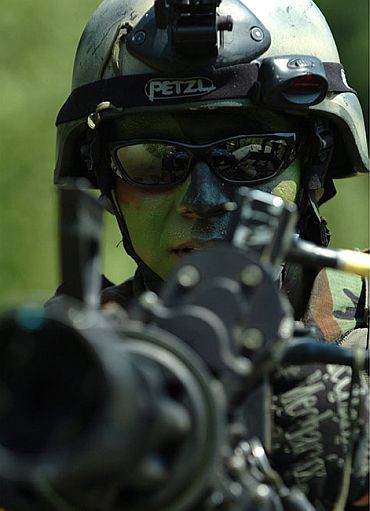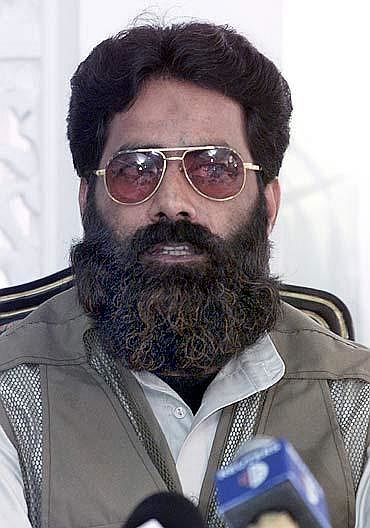It remains to be seen whether the death of Ilyas Kashmiri will have any impact on the ability of the Al Qaeda and its affiliates to carry out attacks, says strategic expert B Raman.
The Central Intelligence Agency has not allowed the death of Osama bin Laden to slow down its hunt for high-value targets of the Al Qaeda and its affiliates in the Pashtun tribal belt of Pakistan. bin Laden was killed in a raid by US naval commandos at his hideout in Abbottabad on May 2.
The CIA's relentless search for them through newly-created human sources and drone strikes has been kept up. The successful commando raid at Abbottabad has added to the already existing disruption in the command and control of the Al Qaeda and its affiliates.
Their remaining leaders are on the run relocating themselves in new sanctuaries due to a fear that the CIA may already know of their old sanctuaries as a result of its scrutiny of the documents and computer material seized from Osama bin Laden's hideout.
Their hurried efforts towards relocation have provided the CIA and its drones new opportunities to run them down and eliminate them.
Ilyas Kashmiri, head of the so-called 313 brigade of the Harkat-ul-Jihad-al-Islami, one of the constituent units of the Al Qaeda's International Islamic Front For Jihad Against the Crusaders and the Jewish People, appears to have been successfully hunted down and eliminated along with some associates -- all Pakistanis. They were killed in a drone strike near Wana in south Waziristan on the night of June 3.
Their bodies are reported to have been mutilated beyond recognition and quickly buried by the locals, which makes physical or forensic identification impossible. This admission by a self-proclaimed representative of HuJI in fax messages sent to the local media of Kashmiri's death in a drone strike has added strength to the widely-held belief in the south Waziristan area that Kashmiri is no more.
While one cannot rule out the possibility of the HuJI or its 313 Brigade deliberately disseminating a false claim of his death in order to protect him from the relentless hunt by the CIA, one has to note that there has been no instance in the past of the Al Qaeda or its affiliates disseminating false claims of death in order to protect their leaders.
Is Kashmiri really dead?
Image: Ilyas KashmiriThus, one can be reasonably -- though not for certain -- sure that the CIA has scored another high-value success in eliminating Kashmiri. This will further add to the disruption in the command and control of the Al Qaeda and its affiliates.
After Rashid Rauf, a Mirpuri from Birmingham who was reportedly killed in a drone strike some months ago in the federally administered tribal areas, Ilyas is the second jihadi terrorist of Kashmiri origin associated with the Al Qaeda to have been killed by the CIA. He hailed from the Bhimber area of Pakistan-Occupied Kashmir.
'Kashmiri not of the same class as Khalid Sheikh Mohammed'
Image: Khalid Sheikh MohammedKashmiri was often compared to Khalid Sheikh Mohammed, who orchestrated the 9/11 terrorist strikes in the US, but he was not of the same class as the latter in conceiving and executing spectacular terrorist strikes.
His value to the Al Qaeda arose from the fact that he had a wide network of contacts not only in the Pakistani armed forces and intelligence agencies, but also in the diaspora of Pakistani origin in the West. This enabled him to find new non-Arab volunteers for Al Qaeda's operations in foreign soil.
However, it has to be noted that his spectacular successes were mostly in the Af-Pak and Indian regions. None of his planned operations in the West -- including the plan to blow up the offices of the Danish newspaper that published cartoons of Prophet Mohammed in 1995 -- reached a successful culmination.
Kashmiri did not have a technical bent of mind like Khalid, but he developed an expertise in organising complex swarm attacks using the commando tactics of special forces. The increasing number of such successful swarm attacks by the Lashkar-e-Tayiba, the Tehrik-e-Taliban Pakistan and the Haqqani Network in India, Pakistan and Afghanistan bore his signature and signs of his expertise and training.
It remains to be seen whether his death will have any impact on the ability of the Al Qaeda and its affiliates to carry out such swarm attacks in future.




article